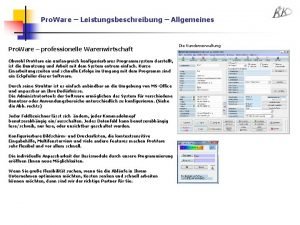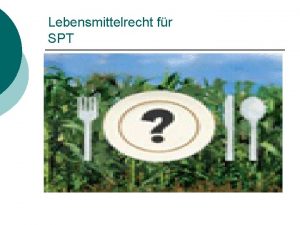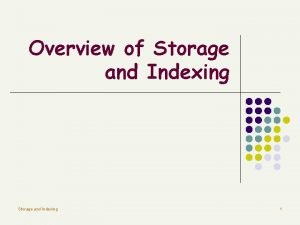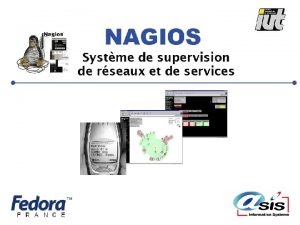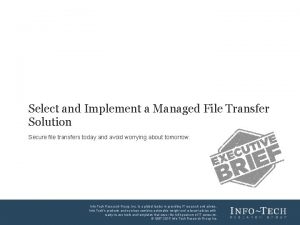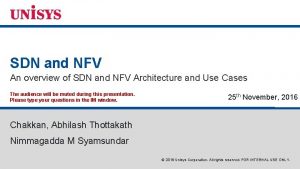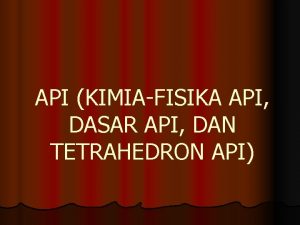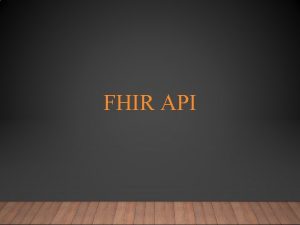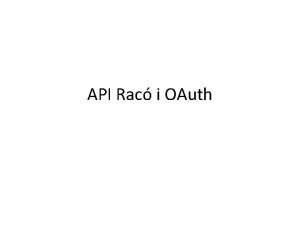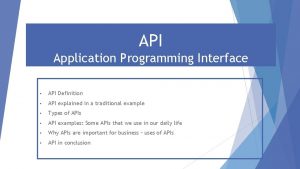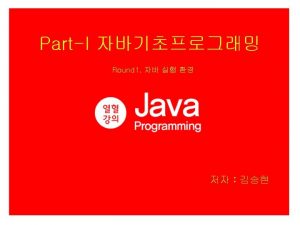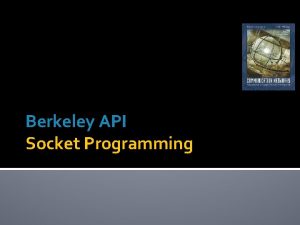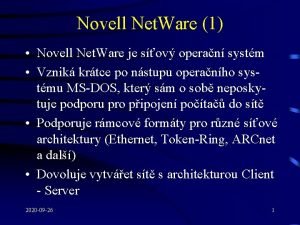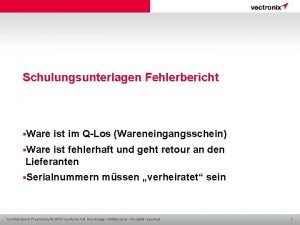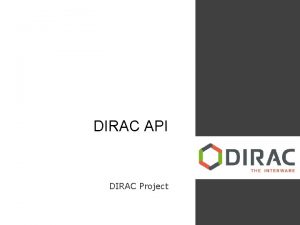VTDXML Introduction and API Overview Ximple Ware infoximpleware












![Methods of VTDGen q void set. Doc (byte[] ba): Pass the byte buffer containing Methods of VTDGen q void set. Doc (byte[] ba): Pass the byte buffer containing](https://slidetodoc.com/presentation_image_h/cfe38f0962deb152ac5773af34190768/image-13.jpg)




















![Methods of XMLModifier q. Insert into an XML document Øvoid insert. After. Element(byte[] b)— Methods of XMLModifier q. Insert into an XML document Øvoid insert. After. Element(byte[] b)—](https://slidetodoc.com/presentation_image_h/cfe38f0962deb152ac5773af34190768/image-34.jpg)

![Methods of XMLModifier q Insert into an XML document Ø void insert. After. Element(byte[] Methods of XMLModifier q Insert into an XML document Ø void insert. After. Element(byte[]](https://slidetodoc.com/presentation_image_h/cfe38f0962deb152ac5773af34190768/image-36.jpg)
![Methods of XMLModifier q Insert into XML document Ø void insert. Attribute(byte[] b): Insert Methods of XMLModifier q Insert into XML document Ø void insert. Attribute(byte[] b): Insert](https://slidetodoc.com/presentation_image_h/cfe38f0962deb152ac5773af34190768/image-37.jpg)




![Exception Handling: Java vs. C public static void main(String argv[]){ try { // put Exception Handling: Java vs. C public static void main(String argv[]){ try { // put](https://slidetodoc.com/presentation_image_h/cfe38f0962deb152ac5773af34190768/image-42.jpg)


- Slides: 44

VTD-XML Introduction and API Overview Ximple. Ware info@ximpleware. com 2/2008

Agenda q. Motivations Behind VTD-XML q. Why VTD-XML? q. When to Use VTD-XML? q. Basic Concept q. Essential Classes and Methods q. VTD-XML in C and C# q. Summary

Motivations Behind VTD-XML q*Numerous*, well-known issues of old XML processing models, below summarizes a few: ØDOM: Too slow and resource intensive ØSAX: Forward only; treat XML as CSV; performance/memory benefits insufficient to justify its difficulty ØPull: Only programming style change; inherit most of the problems from SAX q. Enterprise developers have no other via options

Why VTD-XML? q The next generation XML processing model that is simultaneously: v. The world’s fastest XML parser (1. 5 x~3 x of SAX with null content handler) v. The world’s most memory efficient, randomaccess-capable XML parser (1. 3 x~1. 5 x size of the XML document) v. The world’s first XML parser supporting incremental update v. The world’s first XML parser with built-in indexing feature (aka. VTD+XML) v. The world’s first XML parser that is portable to ASIC v. The world’s first XML parser with built-in buffer reuse feature

When to Use VTD-XML? q. The scenarios that you may consider using VTD-XML v. Large XML files that DOM can’t handle v. Performance-critical transactional Web- Services/SOA applications v. Native XML database applications v. Network-based XML content switching/routing/security applications

Known Limitations q Not yet support external entities (those declared within DTD) q Not yet process DTD (return as a single VTD record) q Schema validation feature is planned for a future release. q Extreme long (>=512 chars) element/attribute names or ultra deep document (>= 255 levels) will cause parse exception

Basic Concept q Non-extractive tokenization based on Virtual Token Descriptor (VTD): use 64 -bit integers to encode offsets, lengths, token types, depths q The XML document is kept intact and undecoded.

Basic Concept q In other words, in vast majority of the cases string allocation is *unnecessary*, and nothing but a waste of CPU and memory q VTD-XML performs many string operations directly on VTD records v. String to VTD record comparison (both boolean and lexicographically) v. Direct conversions from VTD records to ints, longs, floats and doubles v. VTD record to String conversion also provided, but avoid them whenever possible for performance reasons

Basic Concept q. VTD-XML’s document hierarchy consists *exclusively* of elements q. Move a single, global cursor to different locations in the document tree q. Many VTDNav’s methods identify a VTD record with its index value q-1 corresponds to “no such record”

Essential Classes q. VTDGen: Encapsulates the parsing, indexing routines q. VTDNav: VTD navigator allows cursorbased random access and various functions operating on VTD records q. Auto. Pilot: Contains XPath and Node iteration functions q. XMLModifier: Incrementally update XML

Essential Classes q Exceptions Ø Parse. Exception: Thrown during parsing when XML is not well-formed Ø Indexing. Read. Exception: Thrown by VTDGen when there is error in loading index Ø Indexing. Write. Exception: Thrown by VTDGen when there is error writing index Ø Nav. Exception: Thrown when there is an exception condition when navigating VTD records Ø Pilot. Exception: Child class of Nav. Exception; thrown when using auto. Pilot to perform node iteration. Ø XPath. Parse. Exception: Thrown by auto. Pilot when compiling an XPath expression Ø XPath. Eval. Exception: Thrown by auto. Pilot when evaluating an XPath expression Ø Modify. Exception: Thrown by XMLModifier when updating XML file

Typical Programming Flows Call VTDGen’s parse. File(…) Start with a byte buffer containing the content of XML, call set_doc() of VTDGen Call VTDGen’s load. Index(…) Call VTDGen’s parse() Obtain an instance VTDNav from VTDGen Move VTDNav’s cursor manually to various locations and perform corresponding application logic Instantiate auto. Pilot for node iteration and XPath to perform Corresponding application logic
![Methods of VTDGen q void set Doc byte ba Pass the byte buffer containing Methods of VTDGen q void set. Doc (byte[] ba): Pass the byte buffer containing](https://slidetodoc.com/presentation_image_h/cfe38f0962deb152ac5773af34190768/image-13.jpg)
Methods of VTDGen q void set. Doc (byte[] ba): Pass the byte buffer containing the XML document q void set. Doc_BR (byte[] ba): Pass the byte buffer containing the XML document, with Buffer Reuse feature turned on. q void set. Doc (byte[] ba, int offset, int length): Pass the byte buffer containing the XML document, offset and length further specify the start and end of the XML document in the buffer q void set. Doc_BR (byte[] ba, int offset, int length): Pass the byte buffer containing the XML document, offset and length further specify the start and end of the XML document in the buffer, with Buffer Reuse feature turned on

Methods of VTDGen q void parse(): The main parsing function, internally generates VTD records, etc. q boolean parse. File(String file. Name, boolean ns): Directly parse an XML file of the given name q boolean parse. Http. Url(String file. Name, boolean ns): Directly parse an XML file of the given name q VTDNav get. Nav(): If parse() or parse. File(…) succeed, this method returns an instance of VTDNav q void clear(): Clear the internal state of VTDGen. This method is called internally by get. Nav(); call this method explicitly between successive parse()

Methods of VTDGen q VTDNav load. Index(Input. Stream is): Load index from input stream q VTDNav load. Index(String file. Name): Load index from a file (recommended extension vxl) q VTDNav load. Index(byte[] ba): If parse() or parse. File(…) succeed, this method returns an instance of VTDNav q void write. Index(Output. Stream os): Write the index into output stream q void write. Index(String file. Name): Write index into a file q long get. Index. Size(): Pre-compute the size of VTD+XML index

Methods of VTDNav q. The main navigation functions that moves the global cursor: Øboolean to. Element (int direction) Øboolean to. Element (int direction, String element. Name) Øboolean to. Element. NS (int direction, String URL, String local. Name) Ø“Direction” takes one of the following constants (self-explanatory): PARENT, ROOT, FIRST_CHILD, LAST_CHILD, FIRST_SIBLING, LAST_SIBLING

Methods of VTDNav q Attribute lookup methods for the element at the cursor position Ø int get. Attr. Val (String attr. Name) Ø int get. Attr. Val. NS (String URL, String local. Name) Ø int get. Attr. Count(): Return the attribute count of the element at the cursor position. q Attribute Existence Test for the element at the cursor position Ø boolean has. Attr (String attr. Name) Ø boolean has. Attr. NS (String URL, String local. Name)

Methods of VTDNav q. Retrieve Text Node Øint get. Text(): Returns the index value of the VTD record corresponding to character data or CDATA ØMore sophisticated retrieval, such as mixed content, available in Text. Iter class

Methods of VTDNav q VTD to String boolean comparison functions Ø boolean match. Element (String en): Test if the current element matches the given name. Ø boolean match. Element. NS (String URL, String local. Name): Test whether the current element matches the given namespace URL and local. Name. Ø boolean match. Raw. Token. String (int index, String s): Match the string against the token at the given index value. Ø boolean match. Tokens (int i 1, VTDNav vn 2, int i 2): This method compares two VTD records of VTDNav objects Ø boolean match. Token. String (int index, String s): Match the string against the token at the given index value.

Methods of VTDNav q VTD to String lexical comparison functions Ø int compare. Raw. Token. String (int index, String s): Compare the token at the given index value against a string (returns 1, 0, or -1). Ø int compare. Tokens (int i 1, VTDNav vn 2, int i 2): This method compares two VTD records of VTDNav objects (returns 1, 0, or -1). Ø boolean compare. Token. String (int index, String s): Compare the token at the given index value against a string.

Methods of VTDNav q. Query cursor attributes Øint get. Current. Depth(): Get the depth (>=0) of the element at the cursor position Øint get. Current. Index(): Get the index value of the element at the cursor position. Ølong get. Element. Fragment(): Get the starting offset and length of an element encoded in a long, upper 32 bit is length; lower 32 bit is offset; Unit is in bytes.

Methods of VTDNav q. VTD to other data types conversions Ødouble parse. Double (int index): Convert a VTD record into a double. Øfloat parse. Float (int index): Convert a VTD record into a float. Øint parse. Int (int index): Convert a VTD record into an int. Ølong parse. Long (int index): Convert a VTD record into a long.

Methods of VTDNav q Convert VTD records into Strings Ø String to. Normalized. String (int index): This method normalizes a token into a string in a way that resembles DOM: starting and ending white spaces are stripped, and successive white spaces in the middleware collapsed into a single space char Ø String to. Raw. String (int index): Convert a token at the given index to a String, (built-in entity and char references not resolved) (entities and char references not expanded). Ø String to. String (int index): Convert a token at the given index to a String, (entities and char references resolved).

Methods of VTDNav q Querying attributes of an VTD record Ø int get. Token. Depth (int index): Get the depth value of a token (>=0). Ø int get. Token. Length (int index): Get the token length at the given index value please refer to VTD spec for more details. Length is in terms of the UTF char unit. For prefixed tokens, it is the qualified name length. Ø int get. Token. Offset (int index): Get the starting offset of the token at the given index. Ø int get. Token. Type (int index): Get the token type of the token at the given index value.

Methods of VTDNav q. Access the global stack Øvoid push(): push the cursor position into the global Øboolean pop(): Load the saved cursor position q. To cache/save cursor positions for later sequential access, use Node. Recorder class

Methods of VTDNav q. Query the attributes of parsed XML Øint get. Encoding(): Get the encoding of the XML document. Øint get. Nesting. Level(): Get the maximum nesting depth of the XML document (>0). Øint get. Root. Index(): Get root index value , which is the index value of document element Øint get. Token. Count(): Get total number of VTD tokens for the current XML document. ØIByte. Buffer get. XML(): Get the XML document

Methods of VTDNav q. Writing VTD+XML Index Øvoid write. Index(Output. Stream os): Write the index into output stream Øvoid write. Index(String file. Name): Write index into a file Ølong get. Index. Size(): Pre-compute the size of VTD+XML index

Methods of Auto. Pilot q. Constructors ØAuto. Pilot (VTDNav v): Auto. Pilot constructor comment. ØAuto. Pilot (): Use this constructor for delayed binding to VTDNav which allows the reuse of XPath expression q. Bind VTDNav object to Auto. Pilot Øvoid bind(VTDNav vn): It resets the internal state of Auto. Pilot so one can attach a VTDNav object to the auto. Pilot

Methods of Auto. Pilot q XPath Related Ø void declare. XPath. Name. Space (String prefix, String URL): This function creates URL ns prefix and is intended to be called prior to select. XPath Ø void select. XPath (String s): This method selects the string representing XPath expression Usually eval. XPath is called afterwards Ø String get. Expr. String (): Convert the expression to a string For debugging purpose Ø void reset. XPath (): Reset the XPath so the XPath Expression can be reused and revaluated in anther context position

Methods of Auto. Pilot q XPath Related Ø int eval. XPath (): This method moves to the next node in the nodeset and returns corresponding VTD index value. It returns -1 if there is no more node After finishing evaluating, don't forget to reset the xpath Ø double eval. XPath. To. Number (): This function evaluates an XPath expression to a double Ø String eval. XPath. To. String (): This method returns XPath expression to a String Ø String eval. XPath. To. Boolean (): This method evaluates an XPath expression to a boolean

Methods of Auto. Pilot q. Emulate DOM’s Node Iterator Øvoid select. Element (String en): Select the element name before iterating. Øvoid select. Element. NS (String URL, String local. Name): Select the element name (name space version) before iterating. Øboolean iterate (): Iterate over all the selected element nodes in document order.

Methods of XMLModifier q. Constructors ØXMLModifier(VTDNav v): XMLModifier constructor that binds VTDNav directly. ØXMLModifier(): Use this constructor for delayed binding to VTDNav q. Bind VTDNav object to XMLModifier Øvoid bind(VTDNav vn): It resets the internal state of Auto. Pilot so one can attach a VTDNav object to the XMLModifier

Methods of XMLModifier q. Remove from the XML document Øvoid remove (): Remove whatever that is pointed to by the cursor Øvoid remove. Attribute(int attr. Name. Index ): Remove an attribute name/value pair as referenced by the attr. Name. Index. Øboolean remove. Token(int i): Remove the token at the index position Øboolean remove. Content(int offset, int len): Remove a segment of byte content from master XML doc.
![Methods of XMLModifier q Insert into an XML document Øvoid insert After Elementbyte b Methods of XMLModifier q. Insert into an XML document Øvoid insert. After. Element(byte[] b)—](https://slidetodoc.com/presentation_image_h/cfe38f0962deb152ac5773af34190768/image-34.jpg)
Methods of XMLModifier q. Insert into an XML document Øvoid insert. After. Element(byte[] b)— This method inserts the byte array b after the cursor element Øvoid insert. After. Element(String s)— This method inserts the byte value of s after the element Øvoid insert. Before. Element(byte[] b)— Insert a byte array before the cursor element Øvoid insert. Before. Element(String attr)— Insert a String before the cursor element

Methods of XMLModifier q Insert into an XML document Ø void insert. After. Element(int src_encoding, byte[] b) Insert a byte array of given encoding into the master document. Ø void insert. After. Element(int src_encoding, byte[] b, int content. Offset, int content. Len) Insert the transcoded array of bytes of a segment of the byte array b after the element Ø void insert. Before. Element(int src_encoding, byte[] b) Insert insert the transcoded representatin of the byte array b before the cursor element Ø void insert. Before. Element(int src_encoding, byte[] b, int content. Offset, int content. Len) Insert the transcoded representation of a segment of the byte array b before the cursor element.
![Methods of XMLModifier q Insert into an XML document Ø void insert After Elementbyte Methods of XMLModifier q Insert into an XML document Ø void insert. After. Element(byte[]](https://slidetodoc.com/presentation_image_h/cfe38f0962deb152ac5773af34190768/image-36.jpg)
Methods of XMLModifier q Insert into an XML document Ø void insert. After. Element(byte[] b, int content. Offset, int content. Len )— This method inserts a segment of the byte array b after the cursor element Ø void insert. Before. Element(byte[] b, int content. Offset, int content. Len )— Insert the segment of a byte array before the cursor element Ø void insert. After. Element(Element. Fragment. Ns ef )— Insert a namespace compensated element after the cursor element Ø void insert. Before. Element(Element. Fragment. Ns ef) —Insert a namespace compensated element before the cursor element
![Methods of XMLModifier q Insert into XML document Ø void insert Attributebyte b Insert Methods of XMLModifier q Insert into XML document Ø void insert. Attribute(byte[] b): Insert](https://slidetodoc.com/presentation_image_h/cfe38f0962deb152ac5773af34190768/image-37.jpg)
Methods of XMLModifier q Insert into XML document Ø void insert. Attribute(byte[] b): Insert the byte array representation of attribute name/value pair after the starting tag of the cursor element Ø void insert. Attribute(String attr ): Insert the String representation of attribute name/value pair after the starting tag of the cursor element Ø void insert. Bytes. At(int offset, byte[] content) insert the byte content into XML Ø void insert. Bytes. At(int offset, byte[] content, int content. Offset, int content. Len) Insert a segment of the byte content into XML

Methods of XMLModifier q Update a token in XML Ø void update. Token(int i, byte[] b): Replace the token (of index i) with the byte content of b Ø void update. Token(int i, String new. Content): Replace the token (of index i) with the byte content of String value Ø void update. Token(int index, byte[] new. Content. Bytes, int src_encoding) Update the token with the transcoded representation of given byte array content Ø void update. Token(int index, byte[] new. Content. Bytes, int content. Offset, int content. Len, int src_encoding) Update token with the transcoded representation of a segment of byte array (in terms of offset and length)

Methods of XMLModifier q Generate Output Ø void output(Output. Stream os): Replace the token (of index i) with the byte content of b Ø Void output(java. lang. String file. Name) Generate the updated output XML document and write it into a file of given name q Reset XMLModifier for reuse Ø void reset(): Replace the token (of index i) with the byte content of String value q Other methods Ø int get. Updated. Document. Size(): Compute the size of the updated XML document without composing it

VTD-XML in C q Compared to Java, C is q VTD-XML’s C version uses the following different in the tactics: following aspects: Ø No notion of class Ø No notion of constructor Ø No automatic garbage collection Ø No method/constructor overloading Ø No exception handling Ø Use struct pointer Ø Explicit call “create…” functions Ø Explicit call “free…” functions Ø Pre-pending integer to functions name to differentiate Ø Use <cexcept. h> to provide basic try catch in C

Java Methods vs. C Functions q VTDGen vg = VTDGen(); q Auto garbage collector q void set. Doc(byte[] ba) q void set. Doc(byte[] ba, int doc. Offset, int doc. Len); q VTDGen *vg= create. VTDGen(); q void free. VTDGen (vg); q void set. Doc(VTDGen *vg, UByte* ba, int array. Length); q void set. Doc 2(VTDGen *vg, UByte *ba, int array. Len, int doc. Offset, int doc. Len); q void parse (boolean ns) q parse(VTDGen *vg, boolean ns) q int get. Token. Count() q boolean match. Element(String s); q int get. Token. Count(VTDNav *vn) q Boolean match. Element(VTDNav *vn, UCSChar *s);
![Exception Handling Java vs C public static void mainString argv try put Exception Handling: Java vs. C public static void main(String argv[]){ try { // put](https://slidetodoc.com/presentation_image_h/cfe38f0962deb152ac5773af34190768/image-42.jpg)
Exception Handling: Java vs. C public static void main(String argv[]){ try { // put the code throwing //exceptions here } catch (Exception e){ // handle exception in here } } // set up global exception context struct exception_context the_exception_context[1]; int main(){ // declare exception e; Try { // put the code throwing // exceptions here } Catch (e) { // handle exception in here } }

VTD-XML in C# q. Compared to Java, C# is very similar, so the Java code looks and feels the same as the C# code.

Summary q. This presentation provides the basic introduction and API overview for VTDXML q. Any questions or suggestions? Join our discussion group q. Want to get involved? Having a good idea extending VTD-XML? Write to us: info@ximpleware. com
 What is bioinformatics an introduction and overview
What is bioinformatics an introduction and overview Pro ware
Pro ware Odessy ware
Odessy ware Ware significato informatico
Ware significato informatico Gcu antelope scholarship
Gcu antelope scholarship Parts of the front bar
Parts of the front bar Unix ware
Unix ware Preisangabenverordnung preisschild
Preisangabenverordnung preisschild Docu ware
Docu ware Kevin ware injury
Kevin ware injury Roger ware
Roger ware Rena ware material
Rena ware material Ware fc
Ware fc Tyrone ware
Tyrone ware 오렌지 프로시저 디버깅
오렌지 프로시저 디버깅 3 ware
3 ware Introduction product overview
Introduction product overview Introduction product overview
Introduction product overview Introduction product overview
Introduction product overview Introduction product overview
Introduction product overview Overview of transcription and translation
Overview of transcription and translation Data quality and data cleaning an overview
Data quality and data cleaning an overview Group of carbon
Group of carbon An overview of data warehousing and olap technology
An overview of data warehousing and olap technology An overview of data warehousing and olap technology
An overview of data warehousing and olap technology Data quality and data cleaning an overview
Data quality and data cleaning an overview Data quality and data cleaning an overview
Data quality and data cleaning an overview Overview of storage and indexing
Overview of storage and indexing Elements and their properties section 1 metals
Elements and their properties section 1 metals Essay structure
Essay structure Overview of www
Overview of www Maximo overview
Maximo overview Universal modelling language
Universal modelling language Uml
Uml Vertical overview
Vertical overview Figure 12-1 provides an overview of the lymphatic vessels
Figure 12-1 provides an overview of the lymphatic vessels Lung blood supply
Lung blood supply Texas recapture districts
Texas recapture districts Walmart inventory management systems
Walmart inventory management systems Stylistic overview
Stylistic overview Jackson structured development
Jackson structured development Spring framework overview
Spring framework overview Nagios tactical overview
Nagios tactical overview Market overview managed file transfer solutions
Market overview managed file transfer solutions Sdn vs nfv
Sdn vs nfv

